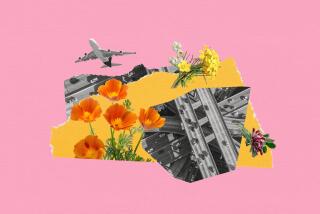BOOK REVIEW : Search for Environmental View of Design
- Share via
OUT OF PLACE Restoring Identity to the Regional Landscape by Michael Hough Yale University Press $35, 225 pages, illustrated
In this dehumanizing, auto-dominated, market-research-driven age of faltering standards of service and aesthetics, our urban and suburban landscapes are becoming more homogenized and worse.
What character their history and ecology might offer is being strip-mined to make way for anonymous residential projects, monolithic office towers, climate-controlled retail complexes of questionable design and awkward transportation systems--all in the abused name of progress.
We are talking here of the march of mini-malls and “McMansions.”
Often overwhelmed by a despotic development process and the resulting insensitive designs are the people the projects are supposed to serve. While our world, to be viable, needs to accommodate change--indeed change is the hallmark of civilization--the challenge is that in its pursuit the quality of life and the bonding of communities be improved rather than impaired.
For this to happen we desperately need a better understanding of what makes our man-made environments attractive, congenial and memorable. In short, what lends them a sense of place.
“Out of Place” by Michael Hough is the latest in a recent and welcome spate of books that attempts to identify and celebrate this elusive sense of place. The books include within the last year William H. Whyte’s “City” (Doubleday) and Roberta Brandes Gratz’s “The Living City”(Simon & Schuster), which focused mostly on site-specific, viable downtown and urban neighborhoods, and Ray Oldenburg’s “The Great Good Place” (Paragon), which in good cheer studies cafes, bars, coffee shops, general stores and similar hangouts “that get you through the day.”
Hough’s view is considerably broader and more ambitious, exploring how the varied biophysical and social forces that have created identifiable landscapes in the past are being too often ignored in today’s shaping, and misshaping, of the post-industrial landscape. According to the author, the book “is a search for an environmental view of design that recognizes the realities of the contemporary scene, that draws its inspiration from the ecological and cultural lessons of the vernacular, and that emphasizes the need for a sustainable view of the future.”
Examined for what makes them special are the diverse land- and cityscapes of Hough’s Toronto, where he works as a landscape architect, and, among other places, Istanbul, Hong Kong, Edinburgh, Tuscany, Tucson and the Hudson Bay lowlands of his memory. Attacked is suburban sprawl and sameness.
Hough’s discussion of how we perceive and respond to different places, be they naturally or culturally formed, displays an engaging directness happily free of the pseudo-scientific jargon of forced quantitative studies favored these days in the dark recesses of academia. Hough’s approach is refreshingly qualitative, a guide of sorts to better viewing, understanding and appreciating our surroundings. Unfortunately, the narrative is not matched by the photographs and illustrations; most are neither of good quality nor clear. The design does not help.
Again and again in almost every example cited, Hough stresses the need for a perspective rooted in a respect for a region’s ecological and cultural diversity. “If we look for it, the inherent potential for diversity shines like a beacon through the placeless dreariness of much contemporary urbanization,” declares Hough. No doubt his own ability to see such potential was sharpened considerably by his years of practice in Canada, a country that at first glance defines bland.
Particularly provocative is Hough’s questioning of the tendency among designers and developers to impose relatively abstract plans on select locations, be the plans hailed as utopian, urban villages, pedestrian pockets, traditional towns or, more bluntly, marketable. He notes the usual dichotomy between the idealized plan (what the designer has in mind) and the need to observe the nature of the place (what the landscape is and how it works), concluding that “the true nature of the regional imperative has little to do with megaprojects or utopian dreams.” He rails against projects that are abstractly designed and imposed without regard to context or user.
Hough calls for simple common sense and a little humility in the design process. His “principles for regional design” include getting to know the peculiar physical and social characteristics of a location; respecting its history; understanding its potential; starting where it is easiest; and, when in doubt, doing as little as possible.
The total is a reasoned plea to embrace and protect the elements of our natural and man-made environments that generate color and character--that make them unique--be they a grove of oaks, a stretch of beach, a canyon view, an ethnic enclave or a landmark building.
It is these things that lend a land and cityscape memory, and life.
More to Read
The biggest entertainment stories
Get our big stories about Hollywood, film, television, music, arts, culture and more right in your inbox as soon as they publish.
You may occasionally receive promotional content from the Los Angeles Times.










